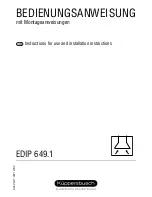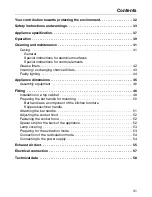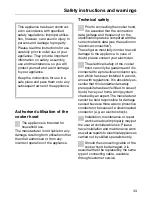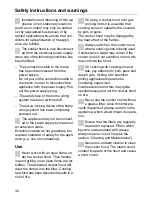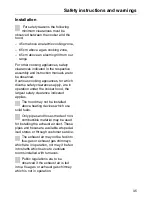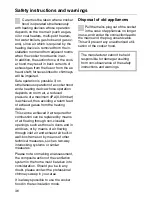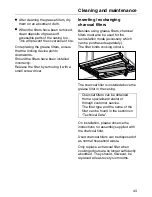
36
Care must be taken when a cooker
hood is operated simultaneously
with heating devices whose operation
depends on the room air (such as gas,
oil or coal heaters, multi-point heaters,
hot water boilers, gas hobs and gas ov-
ens), since air which is required by the
heating device is removed from the in-
stallation room and from adjacent rooms
when the cooker hood sucks in air.
In addition, the suction force of the cook-
er hood may result in back currents of
exhaust gas from the flue or from the ex-
haust shaft; furnaces linked to chimneys
will be impaired.
Safe operation is possible if, on
simultaneous operation of a cooker hood
and a heating device whose operation
depends on room air, a reduced
pressure of a maximum 4Pa (0.04 mbar)
is achieved, thus avoiding a return feed
of exhaust gases from the heating
device.
This can be achieved if air required for
combustion can be replaced by means
of air flowing through non-closable
openings, such as those in doors and in
windows, or by means of air flowing
through inlet air and exhaust air built-in
wall-box frames or by means of other
technical measures, such as two-way
interlocking systems or similar
measures.
Please note: on making an assessment,
the composite action of the ventilation
system in the home must be taken into
consideration. Should you be in any
doubt, please contact the professional
chimney sweep in your area.
It is always possible to use the cooker
hood in the recirculation mode.
Disposal of old appliances
Pull the mains plug out of the socket
in the case of appliances no longer
in use, and render the connection lead to
the mains and the plug unservicable.
This will prevent any unauthorised utili-
sation of the cooker hood.
The manufacturer cannot be held
responsible for damage resulting
from non-observance of the safety
instructions and warnings.
Safety instructions and warnings
Summary of Contents for EDIP 649.1
Page 8: ...37 Appliance specification...
Page 17: ...46 Assembly equipment Fitting...

